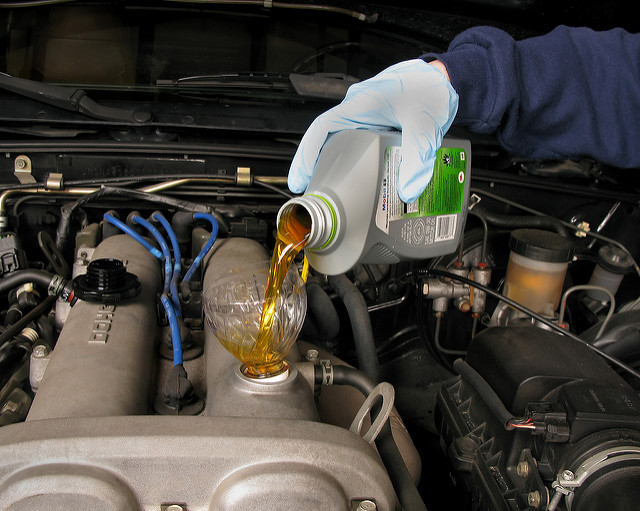 If auto mechanics were comedians, they’d have a lot of laugh-out-loud stories to share about Do-It-Yourself auto repair gone wrong. From more common auto repair errors to “You did what!” expletives, any seasoned mechanic will have his or her tales to tell. Many at-home auto repair failures have to do with using the wrong tools for the job, incomplete work, or improper oil changes.
If auto mechanics were comedians, they’d have a lot of laugh-out-loud stories to share about Do-It-Yourself auto repair gone wrong. From more common auto repair errors to “You did what!” expletives, any seasoned mechanic will have his or her tales to tell. Many at-home auto repair failures have to do with using the wrong tools for the job, incomplete work, or improper oil changes.
Oil changes are essential to the wellbeing of your car, truck or SUV. Everyone’s heard that one-hundred times and every mechanic preaches it dozens of times a day. Yet somehow drivers routinely forget or forego the necessary oil change and continue to drive the car month after month.
Eventually, the oil will coagulate and turn into thick sludge. In such a case, your engine will seize up and have to be replaced. Engine repair is an expensive and messy undertaking even all the more painful because it is usually preventable.
Excuses San Diego Auto Repair Shops Hear for Not Changing the Oil Include:
- It’s too expensive (compare a $49 oil change to a several thousand dollar engine repair and replacement).
- Oil change isn’t really necessary.
- The auto repair shop is trying to rip me off with extras like oil changes.
- I’ll change it myself, when I get around to it.
- I didn’t know I needed to change the oil filter, too.
Oil Change Mistakes That Even the Experts Can Make
Changing the oil is a maintenance task most people can do at-home with minimal tools and skills. That being said, if you are planning on going under the vehicle, it’s important to have the proper apparatuses you need to do the job right and safely. A sloppy or poorly performed oil change could cause other problems to the vehicle leading to engine repair.
Using the wrong grade or type of oil, which could damage engine, pistons or hydraulic components, is a common error for at-home oil changes. While you could get away with using the wrong oil 25 years ago, today’s cars are highly calibrated and using a specific grade oil is important for optimum performance.
Your mom always told you to put the cap back on your markers or your Elmer’s glue, and with good reason. Fail to put the cap back on, and the oil will fall or drip out causing major engine damage. This mistake purportedly happens in fast lube type oil change shops, particularly lube shops where a technician changes the oil of car after car, all day long. One way to prevent loss of the elusive oil cap is to place it somewhere that it can’t be overlooked.
Another typical problem with at-home oil changes is over- or under-filling. Too much and the oil can spill out and cause gaskets to leak. Too little and the oil may not be able to lubricate the engine and its moving parts properly. Aren’t sure how much oil is enough? Then it’s best to bring it in to a San Diego auto repair shop.
And believe it or not, another mistake DIY’ers make with regard to home oil changes is failing to refill the vehicle with said oil after draining the old oil. This can happen if you get too busy, distracted and forget what you were doing. You turn the engine over with no oil in it at all and your car repair problems will start real quick.
Other Auto Repairs Not Related to Oil Change?
Another common mistake auto repair shops in San Diego see all the time is damage to the vehicle as a result of failure to use the proper tools. For example, the stripping of bolts or screws often happens as a result of failure to use the proper wrench or tool.
The amateur mechanic opts to grab any wrench-like object lying around the garage and then forcibly remove the bolt or lug nut. What happens is the tool grips the nuts or bolts incorrectly and then strips it to the bone or breaks it off entirely.
Uh-oh. Now you have two problems to solve instead of just one. Sometimes the person will go ahead and try to solve this second problem they’ve created by getting out the drill. Yikes! Drill a hole in the wrong spot and you can be in for some serious damage and auto repair.
Using the Wrong Fluids for At-home Auto Repair
This leads to another frequently seen issue … not following the vehicle owners’ manual. Vehicle components aren’t always where you think they’d be. Using a manual can help you know for sure you’re putting oil where the oil should go and coolant where the coolant should go. (Don’t laugh; people add coolant to the oil because they think it’s the cooling system, etc.) Your owner’s manual will have a layout of components under your hood so you know what part’s what.
Do you have a bottle of blueish-greenish gunk in your garage you’re going to add to your car as antifreeze? How long has it been sitting there? Can you read the ingredients / instructions on the bottle? Using the wrong fluid or an expired fluid is another regular error. Everything has a shelf-life and you might want to think twice about putting that not-really-sure-what-it-is fluid into your car as a coolant. Proper lubrication is a must for optimal vehicle functionality. Adding poor quality or incorrect fluids is only likely to cause more problems.






